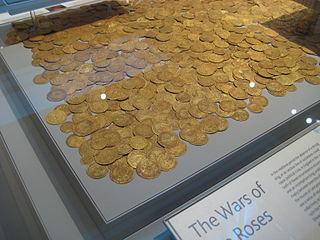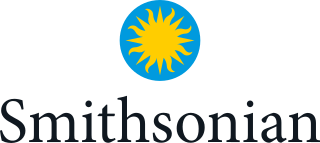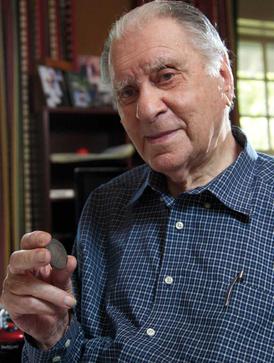
Coin collecting is the collecting of coins or other forms of minted legal tender. Coins of interest to collectors include beautiful, rare, and historically significant pieces. Collectors may be interested, for example, in complete sets of a particular design or denomination, coins that were in circulation for only a brief time, or coins with errors. Coin collecting can be differentiated from numismatics, in that the latter is the systematic study of currency as a whole, though the two disciplines are closely interlinked.

Numismatics is the study or collection of currency, including coins, tokens, paper money, medals and related objects.

The 1913 Liberty Head nickel is an American five-cent piece which was produced in extremely limited quantities unauthorized by the United States Mint, making it one of the best-known and most coveted rarities in American numismatics. In 1972, one specimen of the five cent coin became the first coin to sell for over US$100,000; in 1996, another specimen became the first to sell for over US$1 million. A specimen was sold for US$3 million in a 2004 private sale, then resold for US$3.7 million at a public auction in 2010.

The American Numismatic Society (ANS) is a New York City-based organization dedicated to the study of coins, money, medals, tokens, and related objects. Founded in 1858, it is the only American museum devoted exclusively to their preservation and study. Its collection encompasses nearly one million items, including medals and paper money, as well as the world's most comprehensive library of numismatic literature. The current President of the Society, Dr. Ute Wartenberg, served as the Executive Director for two decades and was succeeded in this role by Dr. Gilles Bransbourg.

The Museo Casa de Moneda is a numismatics museum located in La Candelaria neighborhood of Bogotá, Colombia. It is managed by the Bank of the Republic of Colombia and used to display its numismatic collection that is composed by around 18,600 objects that include artwork, banknotes, bonds, coins, derivatives, medals, negotiable instruments, and printing instruments from various periods and regions of the world.

The British Museum Department of Coins and Medals is a department of the British Museum involving the collection, research and exhibition of numismatics, and comprising the largest library of numismatic artefacts in the United Kingdom, including almost one million coins, medals, tokens and other related objects. The collection spans the history of coinage from its origins in the 7th century BC to the present day, and is representative of both Eastern and Western numismatic traditions.

The Uppsala University Coin Cabinet is one of Sweden's most important public coin and medal collections. It is housed in the main building of Uppsala University.

The National Numismatic Collection is the national coin cabinet of the United States. The collection is part of the Smithsonian Institution's National Museum of American History.

Eric Pfeiffer Newman was an American numismatist. He wrote several "works about early American coins and paper money considered the standards on their subjects", as well as hundreds of articles. Newman sold his coins over auctions in 2013–2014 for over $70 million and used most of that money to fund the Newman Numismatic Education Society and its Newman Numismatic Portal to "make the literature and images of numismatics, particularly American numismatics, available to everyone on a free and forever basis."
Agnes Baldwin Brett was an American numismatist and archaeologist who worked as the Curator at the American Numismatic Society from 1910 to 1913. She was the first paid curator at the American Numismatic Society. She made important contributions to the study of ancient coinage, medals, and sculpture, whose work was used by later archaeologists. Brett was also a visiting lecturer of archaeology at Columbia University in 1936.
A numismatist is a specialist, researcher, and/or well-informed collector of numismatics/coins. Numismatists can include collectors, specialist dealers, and scholar-researchers who use coins in object-based research. Although use of the term numismatics was first recorded in English in 1799, people had been collecting and studying coins long before then all over the world.
Silk Road Numismatics is a special field within Silk Road studies and within numismatics. It is particularly important because it covers a part of the world where history is not always clear – either because the historical record is incomplete or is contested. For example, numismatics has played a central role in determining the chronology of the Kushan kings.
Howard Franklin Bowker (1889-1970) was a numismatist and philatelist, collecting and specialising in Chinese coins, stamps and banknotes. He created the first bibliography of Western language publications on East Asian numismatics.
Helen Kay Wang is an English sinologist and translator. She works as curator of East Asian Money at the British Museum in London. She has also published a number of literary translations from Chinese, including an award-winning translation of a Chinese children's book.
Elvira Eliza Clain-Stefanelli was a numismatist, director of the National Numismatic Collection of the Smithsonian Institution, and advisor to the US Mint.

Elizabeth Jean Elphinstone Pirie was a British numismatist specialising in ninth-century Northumbrian coinage, and museum curator, latterly as Keeper of Archaeology at Leeds City Museum from 1960 to 1991. She wrote eight books and dozens of articles throughout her career. She was a fellow of the Royal Numismatic Society, president of the Yorkshire Numismatic Society and a fellow of the Society of Antiquaries of London.
Martin Allen, FSA, is a British numismatist and historian, specialising in medieval English coinage. Allen is the Senior Assistant Keeper of Numismatics at the Fitzwilliam Museum in Cambridge, United Kingdom.

Ute WartenbergFSA is a German numismatist and the first woman president and executive director of the American Numismatic Society (ANS). Wartenberg serves as an adjunct professor of classics at Columbia University and as the curator of the Amastris Collection, a private collection of Greek coins.










